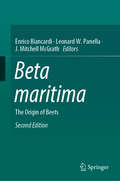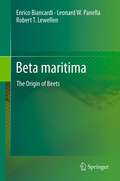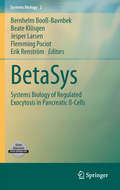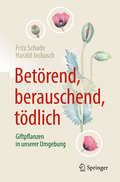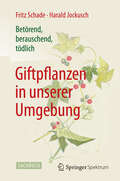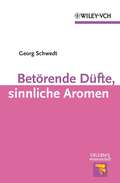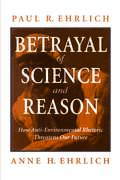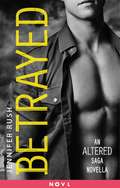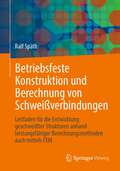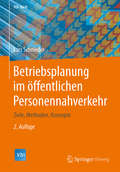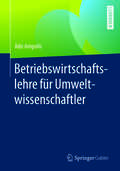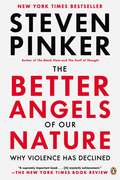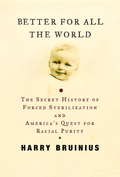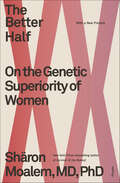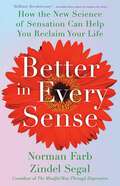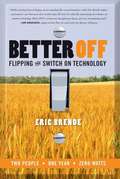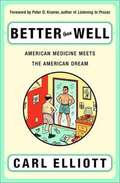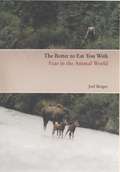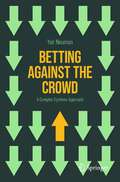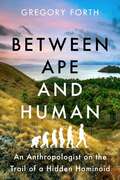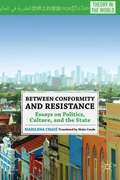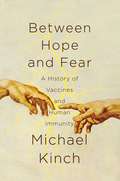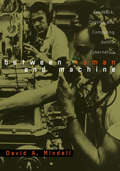- Table View
- List View
Beta maritima: The Origin of Beets
by Leonard W. Panella Enrico Biancardi J. Mitchell McGrathThis book, now in its second edition, provides researchers and operators a complete description of all aspects regarding the wild ancestor of sugar beet. The possibility of crossing modern crops with the ancestors from which they are derived in order to recover some traits lost through domestication is increasingly attracting interest. The selective process implemented by the first growers led to the elimination of features not considered useful at the time. Yet some of these lost traits have now become very important. In fact, in many areas sugar beet cultivation would now be impossible without the transfer of some genetic resistances from Beta maritima, the crop’s ancestor. Moreover, the isolation of such traits is becoming increasingly critical with regard to current and future environmental and economic considerations on e.g. the use of pesticides. This second edition replaces certain photographs and has been updated to reflect the latest advances and findings. One chapter and several sections have been rewritten, and significant revisions have been made throughout the text. The new techniques provide breeders with massively improved analytical means for the safest and fastest selection procedures. Not only will these techniques allow Beta maritima to take on a far greater role as a source of favorable traits; the relative ease with which these characteristics can be transferred will also make it possible to use the germplasm of the whole genus Beta and Patellifolia, which to date has been highly complex, if not impossible, due to the difficulties of hybridization.
Beta maritima: The Origin of Beets
by Leonard W. Panella Robert T. Lewellen Enrico BiancardiAlong the undisturbed shores, especially of the Mediterranean Sea and the European North Atlantic Ocean, is a quite widespread plant called Beta maritima by botanists, or more commonly sea beet. Nothing, for the inexperienced observer's eye, distinguishes it from surrounding wild vegetation. Despite its inconspicuous and nearly invisible flowers, the plant has had and will have invaluable economic and scientific importance. Indeed, according to Linnè, it is considered "the progenitor of the beet crops possibly born from Beta maritima in some foreign country". Recent molecular research confirmed this lineage. Selection applied after domestication has created many cultivated types with different destinations. The wild plant always has been harvested and used both for food and as a medicinal herb. Sea beet crosses easily with the cultivated types. This facilitates the transmission of genetic traits lost during domestication, which selection processes aimed only at features immediately useful to farmers and consumers may have depleted. Indeed, as with several crop wild relatives, Beta maritima has been successfully used to improve cultivated beet's genetic resistances against many diseases and pests. In fact, sugar beet cultivation currently would be impossible in many countries without the recovery of traits preserved in the wild germplasm. Dr. Enrico Biancardi graduated from Bologna University. From 1977 until 2009, he was involved in sugar beet breeding activity by the Istituto Sperimentale per le Colture Industriali (ISCI) formerly Stazione Sperimentale di Bieticoltura (Rovigo, Italy), where he released rhizomania and cercospora resistant germplasm and collected seeds of Mediterranean sea beet populations as a genetic resource for breeding and ex situ conservation. Retired since 2009, he still collaborates with several working breeders, in particular, at the USDA Agricultural Research Stations, at the Chinese Academy of Agricultural Science (CAAS), and at the Athens University (AUA). He has edited books, books chapters and authored more than 150 papers. Dr. Lee Panella is a plant breeder and geneticist with the USDA-ARS at Fort Collins, Colorado. He earned his B.S. in Crop and Soil Science from Michigan State University, an M.S. in Plant Breeding from Texas A&M University, and a Ph.D. in genetics from the University of California at Davis. His research focus is developing disease resistant germplasm using sugar beet wild relatives. He is chairman of the USDA-ARS Sugar Beet Crop Germplasm Committee and has collected and worked extensively with sea beet. Dr. Robert T. Lewellen was raised on a ranch in Eastern Oregon and obtained a B.S. in Crop Science from Oregon State University followed by a Ph.D. from Montana State University in Genetics. From 1966 to 2008 he was a research geneticist for the USDA-ARS at Salinas, California, where he studied the genetics of sugar beet and as a plant breeder, often used sea beet as a genetic source to produce many pest and disease resistant sugar beet germplasm and parental lines, while authoring more than 100 publications.
BetaSys: Systems Biology of Regulated Exocytosis in Pancreatic ß-Cells (Systems Biology)
by Flemming Pociot Erik Renström Bernhelm Booß-Bavnbek Jesper Larsen Beate KlösgenBetaSys uses the example of regulated exocytosis in pancreatic β-cells, and its relevance to diabetes, to illustrate the major concepts of systems biology, its methods and applications.
The Bethe Wavefunction
by Michel GaudinMichel Gaudin's book La fonction d'onde de Bethe is a uniquely influential masterpiece on exactly solvable models of quantum mechanics and statistical physics. Available in English for the first time, this translation brings his classic work to a new generation of graduate students and researchers in physics. It presents a mixture of mathematics interspersed with powerful physical intuition, retaining the author's unmistakably honest tone. The book begins with the Heisenberg spin chain, starting from the coordinate Bethe Ansatz and culminating in a discussion of its thermodynamic properties. Delta-interacting bosons (the Lieb-Liniger model) are then explored, and extended to exactly solvable models associated to a reflection group. After discussing the continuum limit of spin chains, the book covers six- and eight-vertex models in extensive detail, from their lattice definition to their thermodynamics. Later chapters examine advanced topics such as multi-component delta-interacting systems, Gaudin magnets and the Toda chain.
Betörend, berauschend, tödlich - Giftpflanzen in unserer Umgebung
by Fritz Schade Harald JockuschWussten Sie dass durch Honig schon mal eine Schlacht entschieden wurde? dass sich das Reinheitsgebot für Bier ursprünglich gegen eine einheimische Rauschgiftpflanze gerichtet hat? dass der Wunderbaum Palma Christi ein Eiweiß produziert, das im deutschen Kriegswaffenkontrollgesetz aufgeführt wird? wieviele Pflanzen in Ihrem Hausgarten und in Parks giftig sind? Antworten auf viele spannende Fragen wie diese liefert das Giftpflanzenbuch von Fritz Schade und Harald Jockusch. Der Künstler Schade hat Giftpflanzen nach der Natur mit Farbstiften porträtiert, der Biologe Jockusch informiert über botanische, biochemische und toxikologische Fakten. Die Darstellungen werden durch historische Rückblicke, Anekdoten und eigene Erfahrungen aufgelockert. Im Buch folgt die Anordnung der Arten in etwa der jahreszeitlichen Abfolge des ersten Auftretens auffälliger giftiger Pflanzenteile. Wie die üblichen, mit Fotografien bebilderten Giftpflanzenratgeber dient ihr Buch der Gefahrenvermeidung, betont aber auch das Anschauungs- und Lesevergnügen.Die künstlerischen Darstellungen in diesem Buch verbinden ästhetischen Reiz mit hohem Wiedererkennungswert. Sie können leichter verinnerlicht werden als detailreiche Fotografien. Das gilt vor allem für Kinder, die durch Giftpflanzen besonders gefährdet sind. Neben der blühenden wird die fruchtende Pflanze dargestellt, wenn dies für die Vergiftungsgefahr relevant ist. In die 2. Auflage wurden 12 neue Pflanzenarten aufgenommen, von denen einige derzeit die Öffentlichkeit beschäftigen.
Betörend, berauschend, tödlich - Giftpflanzen in unserer Umgebung
by Fritz Schade Harald JockuschWussten Siedass durch Honig schon mal eine Schlacht entschieden wurde?dass sich das Reinheitsgebot für Bier ursprünglich gegen eine einheimische Rauschgiftpflanze gerichtet hat? dass der Wunderbaum Palma Christi ein Eiweiß produziert, das im deutschen Kriegswaffenkontrollgesetz aufgeführt wird?wie bezaubernd schön viele Giftpflanzen sind?Antworten auf viele spannende Fragen wie diese liefert das Giftpflanzenbuch von Fritz Schade und Harald Jockusch. Der Künstler Schade hat Giftpflanzen nach der Natur mit Farbstiften porträtiert, der Biologe Jockusch hat Fachwissen und Anekdotisches aus Gegenwart und Geschichte zu diesen Pflanzen zusammengestellt. Wie die üblichen, mit Fotografien bebilderten Giftpflanzenratgeber dient ihr Buch der Gefahrenvermeidung, betont aber auch das Anschauungs- und Lesevergnügen. Die Autoren beleuchten botanische, biochemische, historische und anekdotische Zusammenhänge für jede Pflanzenart und informieren so auf unterhaltsame Weise. Im Buch folgt die Anordnung der Arten in etwa der jahreszeitlichen Abfolge des ersten Auftretens auffälliger giftiger Pflanzenteile.Die künstlerischen Darstellungen in diesem Buch verbinden ästhetischen Reiz mit hohem Wiedererkennungswert. Sie können leichter verinnerlicht werden als detailreiche Fotografien. Das gilt vor allem für Kinder, die durch Giftpflanzen besonders gefährdet sind. Neben der blühenden wird die fruchtende Pflanze dargestellt, wenn dies für die Vergiftungsgefahr relevant ist.
Betörende Düfte, sinnliche Aromen (Erlebnis Wissenschaft)
by Georg SchwedtWhy do we find some aromas pleasant, sensual or even bewitching, while we turn our nose up at others? Top-selling author Georg Schwedt teaches scientifically-minded readers about scents and perfumes, aromas and spices. In a clever mixture of exact science and entertaining information he describes the manifold facets of the chemistry behind aromas. Topics range from the physiology of smelling, via methods of extracting scents and the creation of ethereal oils right up to such perfume icons as Chanel No. 5 or Tosca. Along the way Schwedt he uncovers fascinating facts from the culture and science of yesteryear and combines these with the latest results from chemistry. As a result, the reader learns about ancient Egyptian methods for making perfume and about the therapeutic use of scents, which can also be experienced in perfume museums.
Betrayal of Science and Reason: How Anti-Environmental Rhetoric Threatens Our Future
by Paul R. Ehrlich Anne H. EhrlichIn this hard-hitting and timely book, world-renowned scientists and writers Paul R. Ehrlich and Anne H. Ehrlich speak out against what they call the "brownlash." Brownlash rhetoric, created by public relations spokespersons and a few dissident scientists, is a deliberate misstatement of scientific findings designed to support an anti-environmental world view and political agenda. As such, it is deeply disturbing to environmental scientists across the country. The agenda of brownlash proponents is rarely revealed, and the confusion and distraction its rhetoric creates among policymakers and the public prolong an already difficult search for realistic and equitable solutions to global environmental problems.In Betrayal of Science and Reason, the Ehrlichs explain clearly and with scientific objectivity the empirical findings behind environmental issues including population growth, desertification, food production, global warming, ozone depletion, acid rain, and biodiversity loss. They systematically debunk revisionist "truths" and counter the erroneous information and misrepresentation put forth by the brownlash, presenting accurate scientific information about current environmental threats that can be used to evaluate critically and respond to the commentary of the brownlash. They include important background material on how science works and provide extensive references to pertinent scientific literature. In addition, they discuss how scientists can speak out on matters of societal urgency yet retain scientific integrity and the support of the scientific community.Betrayal of Science and Reason is an eye-opening look at current environmental problems and the fundamental importance of the scientific process in solving them. It presents unique insight into the sources and implications of anti-environmental rhetoric, and provides readers with a valuable means of understanding and refuting the feel-good fables that constitute the brownlash.
Betrayed: An Altered Saga Novella (Altered)
by Jennifer RushAfter leaving Anna, Sam, Cas, and Nick behind, Trev is on his own and under the watchful eye of the Branch once more. But where do Trev's loyalties really lie? Riley, Trev's overseer, is determined to find out. On Riley's command, Trev sets off on a mission to a small Wisconsin suburb. His order: locate and kill a seemingly innocent teen named Charlie. Trev soon learns, though, not everything is as it seems in this quiet town--most of all Charlie.Find out what Trev's been up to behind the scenes in this Altered Saga original short story.word count: 10,910 words
Betriebsfeste Konstruktion und Berechnung von Schweißverbindungen: Leitfaden für die Entwicklung geschweißter Strukturen anhand leistungsfähiger Berechnungsmethoden auch mittels FEM
by Ralf SpäthSchweißverbindungen zählen nach wie vor zu den wichtigsten stoffschlüssigen Verbindungen. Für die Betriebsfestigkeitsberechnung dieser Verbindungen gibt es zahlreiche Normen und Vorgaben – das Einordnen der verschiedenen Methoden ist auch für den versierten Ingenieur nicht immer einfach. Darüber hinaus wird die FEM-Methode immer wichtiger – auch hier gibt es eine Vielzahl von Modellierungsansätzen. In diesem Buch werden die Grundlagen und die Zusammenhänge der Betriebsfestigkeit von Schweißverbindungen anschaulich und praxisgerecht erläutert, sowohl auf der Basis von „Handrechnungen“ als auch mit FEM-Methoden. Der Leser ist damit in der Lage auch kritische Schweißverbindungen sicher schwingfest zu gestalten, zu berechnen sowie begleitende Labortests zielgerichtet zu planen.
Betriebsplanung im öffentlichen Personennahverkehr: Ziele, Methoden, Konzepte (VDI-Buch)
by Lars SchniederMit diesem Buch erhält der Leser einen umfassenden Einblick in alle für die Planung, Durchführung und Kontrolle des Betriebs öffentlicher Personenverkehrssysteme (ÖPNV) relevanten Aufgaben. Eine besondere Beachtung finden hierbei verkehrsträgerspezifische Besonderheiten, da der Betrieb öffentlicher Personenverkehrssysteme unterschiedlichen Randbedingungen und einer großen Bandbreite einwirkender Störgrößen unterliegt. Die vergleichende Darstellung der Merkmale der Verkehrsträger sowie deren Auswirkung auf die Betriebsplanung fördert das Verständnis der planerischen Aufgaben. Das Buch "Betriebsplanung im öffentlichen Personennahverkehr" ist eine ganzheitliche und übersichtlich strukturierte Darstellung der einzelnen Planungsschritte in Verkehrsunternehmen in ihrem Zusammenhang. Vorhandene Methoden und Lösungsmöglichkeiten werden zusammengestellt und vergleichend diskutiert. Das Buch schließt die bestehende Lücke in der Fachliteratur. Es richtet sich an Angebotsplaner in Verkehrsverbünden, Betriebsplaner in Verkehrsunternehmen sowie planerisch tätigen Mitarbeitern in Ingenieurbüros. Studierende der Verkehrswissenschaften finden im vorliegenden Buch die für die beruflichen Aufgaben notwendige fachliche Vertiefung.
Betriebsplanung im öffentlichen Personennahverkehr: Ziele, Methoden, Konzepte (VDI-Buch)
by Lars SchniederMit diesem Buch erhält der Leser einen umfassenden Einblick in alle für die Planung, Durchführung und Kontrolle des Betriebs öffentlicher Personennahverkehrssysteme (ÖPNV) relevanten Aufgaben. Eine besondere Beachtung finden hierbei verkehrsträgerspezifische Besonderheiten, da der Betrieb des ÖPNV unterschiedlichen Randbedingungen und einer großen Bandbreite einwirkender Störgrößen unterliegt. Die vergleichende Darstellung der Merkmale der Verkehrsträger sowie deren Auswirkung auf die Betriebsplanung fördert das Verständnis der planerischen Aufgaben. Dieses Buch ist eine ganzheitliche und übersichtlich strukturierte Darstellung der einzelnen Planungsschritte in Verkehrsunternehmen in ihrem Zusammenhang. Vorhandene Methoden und Lösungsmöglichkeiten werden zusammengestellt und vergleichend diskutiert.Das Buch bietet beruflichen Neueinsteigern in die Verkehrsbranche eine gute fachliche Einführung in die Komplexität des Systems ÖPNV. Studierende und Lehrende an Hochschulen profitieren von einer strukturierten und ganzheitlichen Darstellung planerischer Prozesse. Für Ingenieurbüros und weitere am Planungsprozess Beteiligte (Politiker, Besteller, Ersteller) liegt der besondere Wert dieses Buches unter anderem in den umfangreichen kapitelbezogenen Literaturverzeichnissen begründet. Diese umfassen alle wesentlichen zum Fachgebiet gehörenden Schriften des zuständigen Verbandes und bieten auf diese Weise einen Ansatzpunkt für eine weiterführende Recherche.
Betriebswirtschaftslehre für Umweltwissenschaftler
by Ado AmpofoDieses Lehrbuch vermittelt Grundkenntnisse im Bereich der Betriebswirtschaftslehre für praxisnah ausgebildete Umweltwissenschaftler. Ein erfolgreiches Agieren als Mitarbeiter mit eigenem Verantwortungsbereich in einem Unternehmen ist ohne betriebswirtschaftliches Wissen praktisch unmöglich. Dies macht es für Fach- und Führungskräfte erforderlich, sich mit den grundlegenden Vorgängen und Zusammenhängen auseinanderzusetzen. Der Autor erläutert mit praxisrelevantem Fokus die Themenbereiche Marketing, Rechnungswesen, Rechtsformen, Forderungsmanagement, Steuern sowie Projekt- und Qualitätsmanagement. Auch die grundlegenden Herausforderungen des Umweltmanagements werden dargestellt. Ein ausführlicher Aufgabenteil mit Lösungen am Ende des Buches unterstützt die Lernkontrolle. Das Buch richtet sich an Umweltwissenschaftler, Umwelttechniker und Umweltingenieure, die die Grundlagen der Betriebswirtschaft erlernen möchten.
The Better Angels of Our Nature: Why Violence Has Declined (Playaway Adult Nonfiction Ser.)
by Steven PinkerFaced with the ceaseless stream of news about war, crime, and terrorism, one could easily think we live in the most violent age ever seen. Yet as New York Times bestselling author Steven Pinker shows in this startling and engaging new work, just the opposite is true: violence has been diminishing for millennia and we may be living in the most peaceful time in our species's existence. For most of history, war, slavery, infanticide, child abuse, assassinations, pogroms, gruesome punishments, deadly quarrels, and genocide were ordinary features of life. But today, Pinker shows (with the help of more than a hundred graphs and maps) all these forms of violence have dwindled and are widely condemned. How has this happened?<P><P> This groundbreaking book continues Pinker's exploration of the essence of human nature, mixing psychology and history to provide a remarkable picture of an increasingly nonviolent world. The key, he explains, is to understand our intrinsic motives- the inner demons that incline us toward violence and the better angels that steer us away-and how changing circumstances have allowed our better angels to prevail. Exploding fatalist myths about humankind's inherent violence and the curse of modernity, this ambitious and provocative book is sure to be hotly debated in living rooms and the Pentagon alike, and will challenge and change the way we think about our society.<P> Chosen for Mark Zuckerberg's "A Year of Books" <P><b>A New York Times Bestseller</b>
Better for All the World
by Harry BruiniusA timely and gripping history of the controversial eugenics movement in America-and the scientists, social reformers and progressives who supported it. In Better for All the World, Harry Bruinius charts the little known history of eugenics in America-a movement that began in the early twentieth century and resulted in the forced sterilization of more than 65,000 people. Bruinius tells the stories of Emma and Carrie Buck, two women trapped in poverty who became the test case in the 1927 supreme court decision allowing forced sterilization for those deemed unfit to procreate. From the reformers who turned local charities into government-run welfare systems promoting social and moral purity, to the influence the American policies had on Nazi Germany's development of "racial hygiene," Bruinius masterfully exposes the players and legislation behind one of America's darkest secrets.
The Better Half: On the Genetic Superiority of Women
by Shäron MoalemA Guardian Book of the WeekLonglisted for the PEN / E. O. Wilson Literary Science Writing AwardAn award-winning physician and scientist makes the game-changing case that genetic females are stronger than males at every stage of lifeHere are some facts: Women live longer than men. They have stronger immune systems. They're better at fighting cancer and surviving famine, and even see the world in a wider variety of colors. They are simply stronger than men at every stage of life. Why is this? And why are we taught the opposite?To find out, Dr. Sharon Moalem drew on his own medical experiences - treating premature babies in the neonatal intensive care unit; recruiting the elderly for neurogenetic studies; tending to HIV-positive orphans in Thailand - and tried to understand why in every instance men were consistently less likely to thrive. The answer, he discovered, lies in our genetics: two X chromosomes offer a powerful survival advantage.With clear, captivating prose that weaves together eye-opening research, case studies, diverse examples ranging from the behavior of honeybees to American pioneers, as well as experiences from his personal life and his own patients, Moalem explains why genetic females triumph over males when it comes to resiliency, intellect, stamina, immunity and much more. He also calls for a reconsideration of our male-centric, one-size-fits-all view of medical studies and even how we prescribe medications - a view that still sees women through the lens of men.Revolutionary and yet utterly convincing, The Better Half will make you see humanity and the survival of our species anew.
Better in Every Sense: How the New Science of Sensation Can Help You Reclaim Your Life
by Norman Farb Zindel SegalRenowned neuroscientist Dr. Norman Farb and clinical psychologist Dr. Zindel Segal reveal how to break out of negative patterns by engaging your senses. For many of us, daily life has stopped making sense. Super-efficient routines that once served us well now stress us out. Patterns of judgment and negative thinking lead to downward emotional spirals. For others, life has simply lost its spark. Where does change come from when habit lets you down? Whether we&’re struggling with a problem, a bad habit, or life in general, we often think we need to be resilient by &“toughing it out&” or &“trying harder.&” But when we do that, our brains double down on the thinking patterns that got us stuck in the first place—even when they clearly aren&’t working for us. Fortunately, the science of sensation provides the key. In Better in Every Sense, neuroscientist Norman Farb and clinical psychologist Zindel Segal explain that the brain has two networks—the rapid problem-solving (habit) network and the sensory network, which is devoted to fresh insight. By tuning into new and everyday sensations—from the feeling of our feet on a crowded street to the sound of birdsong in the park—we can engage the sensory network. When we&’re stressed or stuck, we can pause to notice and feel the dynamic, vibrant world around us and boost our resilience, well-being, health, and creativity wherever we are, in the moment. Grounded in decades of scientific research and filled with simple exercises and practical mental techniques for mastering &“sense foraging,&” Better in Every Sense explores the power of sensory experiences to liberate us from our ruts and dead ends—and help us successfully handle all of life&’s challenges.
Better Off
by Eric BrendeWhat happens when a graduate of MIT, the bastion of technological advancement, and his bride move to a community so primitive in its technology that even Amish groups consider it antiquated? Eric Brende conceives a real-life experiment: to see if, in fact, all our cell phones, wide-screen TVs, and SUVs have made life easier and better -- or whether life would be preferable without them. By turns, the query narrows down to a single question: What is the least we need to achieve the most? With this in mind, the Brendes ditch their car, electric stove, refrigerator, running water, and everything else motorized or "hooked to the grid" and begin an eighteen-month trial run -- one that dramatically changes the way they live, and proves entertaining and surprising to readers. Better OFF is a smart, often comedic, and always riveting book that also mingles scientific analysis with the human story, demonstrating how a world free of technological excess can shrink stress -- and waistlines -- and expand happiness, health, and leisure. Our notion that technophobes are backward gets turned on its head as the Brendes realize that the crucial technological decisions of their adopted Minimite community are made more soberly and deliberately than in the surrounding culture, and the result is greater -- not lesser -- mastery over the conditions of human existence.
Better Than Well: American Medicine Meets the American Dream
by Carl ElliottPsychology aspects of medical options
The Better to Eat You With: Fear in the Animal World
by Joel BergerCan naive animals avoid extinction when they encounter reintroduced carnivores? To what extent is fear culturally transmitted? And how can a better understanding of current predator-prey behavior help demystify past extinctions and inform future conservation? "The Better to Eat You With" is the chronicle of Berger's search for answers. From Yellowstone's elk and wolves to rhinos living with African lions and moose coexisting with tigers and bears in Asia, Berger tracks cultures of fear in animals across continents and climates, engaging readers with a stimulating combination of natural history, personal experience, and conservation.
Betting Against the Crowd: A Complex Systems Approach
by Yair NeumanCrowds are misleading, both in their simplicity and in their complexity. On the one hand, they behave according to expected trends; on the other, they present sudden shifts and frantic, unexpected behavior. Therefore, “betting against the crowd,” whether in politics, sports, or finance, requires a deep understanding of the crowd’s dynamics. In this book, Prof. Neuman addresses this challenge by delving into the complexity of crowds. The book involves foundational issues and novel ideas, such as why crowds behave unexpectedly, why betting against the crowd is possible only in short time frames, why is it important to be attentive to suspicious signs that are indicative of the crowd’s behavior, and why the long tail of fatalities in armed conflicts leaves us surprised by blitz attacks of violent mobs. The book combines scientific knowledge, experiments, and accessible, often humorous, exposition. It can be read by anyone with a basic science education who seeks to understand crowds and how one can act within and against them.
Between Ape and Human: An Anthropologist on the Trail of a Hidden Hominoid
by Gregory ForthA remarkable investigation into the hominoids of Flores Island, their place on the evolutionary spectrum—and whether or not they still survive.While doing fieldwork on the remote Indonesian island of Flores, anthropologist Gregory Forth came across people talking about half-apelike, half-humanlike creatures that once lived in a cave on the slopes of a nearby volcano. Over the years he continued to record what locals had to say about these mystery hominoids while searching for ways to explain them as imaginary symbols of the wild or other cultural representations. Then along came the &‘hobbit&’. In 2003, several skeletons of a small-statured early human species alongside stone tools and animal remains were excavated in a cave in western Flores. Named Homo floresiensis, this ancient hominin was initially believed to have lived until as recently as 12,000 years ago— possibly overlapping with the appearance of Homo sapiens on Flores. In view of this timing and the striking resemblance of floresiensis to the mystery creatures described by the islanders, Forth began to think about the creatures as possibly reflecting a real species, either now extinct but retained in &‘cultural memory&’ or even still surviving. He began to investigate reports from the Lio region of the island where locals described 'ape-men' as still living. Dozens claimed to have even seen them. In Between Ape and Human, we follow Forth on the trail of this mystery hominoid, and the space they occupy in islanders&’ culture as both natural creatures and as supernatural beings. In a narrative filled with adventure, Lio culture and language, zoology and natural history, Forth comes to a startling and controversial conclusion. Unique, important, and thought-provoking, this book will appeal to anyone interested in human evolution, the survival of species (including our own) and how humans might relate to &‘not-quite-human&’ animals. Between Ape and Human is essential reading for all those interested in cryptozoology, and it is the only firsthand investigation by a leading anthropologist into the possible survival of a primitive species of human into recent times—and its coexistence with modern humans.
Between Conformity and Resistance: Essays on Politics, Culture, and the State (Theory in the World)
by Marilena ChauíSince the 1980's, Marilena Chauí's writing has had a profound impact in Brazil, contributing to the academic conversation and resonating in popular culture. Here, in English for the first time, are ten of Chauí's most important essays, with an introduction by Maite Conde which situates the scholarship in the global context.
Between Hope and Fear: A History Of Vaccines And Human Immunity
by Michael KinchA smart and compelling examination of the science of immunity, the public policy implications of vaccine denial, and the real-world outcomes of failing to vaccinate. If you have a child in school, you may have heard stories of long-dormant diseases suddenly reappearing—cases of measles, mumps, rubella, and whooping cough cropping up everywhere from elementary schools to Ivy League universities because a select group of parents refuse to vaccinate their children. Between Hope and Fear tells the remarkable story of vaccine-preventable infectious diseases and their social and political implications. While detailing the history of vaccine invention, Kinch reveals the ominous reality that our victories against vaccine-preventable diseases are not permanent—and could easily be undone. In the tradition of John Barry’s The Great Influenza and Siddhartha Mukherjee’s The Emperor of All Maladies, Between Hope and Fear relates the remarkable intersection of science, technology and disease that has helped eradicate many of the deadliest plagues known to man.
Between Human and Machine: Feedback, Control, and Computing before Cybernetics (Johns Hopkins Studies in the History of Technology)
by David A. MindellToday, we associate the relationship between feedback, control, and computing with Norbert Wiener's 1948 formulation of cybernetics. But the theoretical and practical foundations for cybernetics, control engineering, and digital computing were laid earlier, between the two world wars. In Between Human and Machine: Feedback, Control, and Computing before Cybernetics, David A. Mindell shows how the modern sciences of systems emerged from disparate engineering cultures and their convergence during World War II. Mindell examines four different arenas of control systems research in the United States between the world wars: naval fire control, the Sperry Gyroscope Company, the Bell Telephone Laboratories, and Vannevar Bush's laboratory at MIT. Each of these institutional sites had unique technical problems, organizational imperatives, and working environments, and each fostered a distinct engineering culture. Each also developed technologies to represent the world in a machine.At the beginning of World War II, President Roosevelt established the National Defense Research Committee, one division of which was devoted to control systems. Mindell shows how the NDRC brought together representatives from the four pre-war engineering cultures, and how its projects synthesized conceptions of control, communications, and computing. By the time Wiener articulated his vision, these ideas were already suffusing through engineering. They would profoundly influence the digital world. As a new way to conceptualize the history of computing, this book will be of great interest to historians of science, technology, and culture, as well as computer scientists and theorists. Between Human and Machine: Feedback, Control, and Computing before Cybernetics
